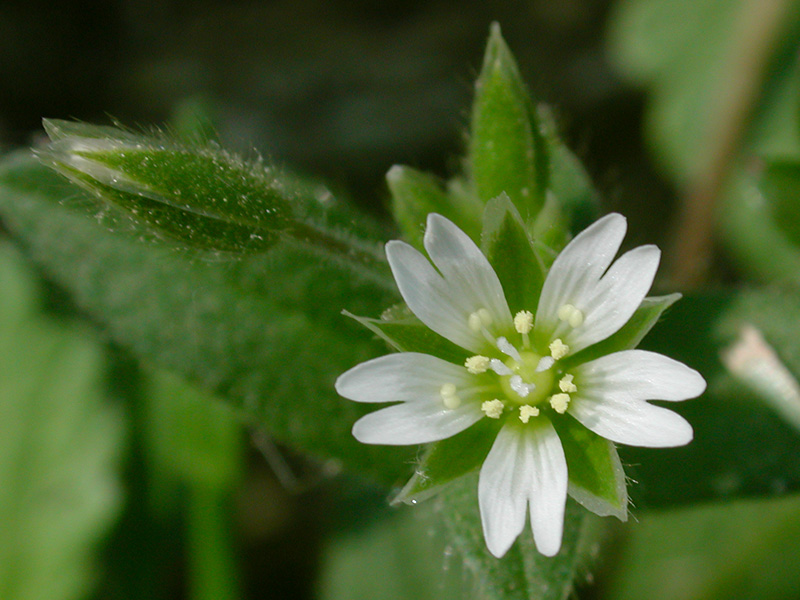Cerastium fontanum
Flower of the ordinary Horn Krauts
The Common chickweed ( Cerastium fontanum Baumg subsp vulgare ( Hartm. ) Greuter & Burdet; Syn: .. Cerastium holosteoides Fr.), even nasty called chickweed, a species of the genus of the Horn herbs ( Cerastium ) within the Caryophyllaceae family is ( Caryophyllaceae ).
- 5.1 Notes and references
- 5.2 External links
Description
Vegetative characteristics
This green wintering, perennial herbaceous plant reaches heights of growth of 5 to 50 centimeters. It forms in addition to a taproot a branched root system from which often develop through root sprouts plants bales of up to 40 centimeters in diameter. Branch from the base ascending, dichtbeblätterte, with about 0.5 millimeters long glandular hairs occupied, dark green stems. The non-flowering stems are much shorter than the flowering.
The oblong- ovate, obtuse pointed leaves are covered with short and sit on the stem. The leaves on the flowerless stems are 7-25 mm long and 2-10 mm wide, while the leaves on the flowering stem up to four inches long and 15 mm wide. They are usually adjacent, arranged crosswise against constantly on the stem of. The lower leaves are herbaceous, and the top usually have a narrow margin of skin on.
Generative features
The crowded crown-shaped inflorescences ( cymes ) consist of a few to many flowers. The petals of the flowers are only slightly longer than the three to seven millimeters long sepals. The flower has five white petals two-part, ten stamens and five pen. The whole plant is hairy stiff up to the sepals and blooms throughout the growing season from March to October.
The cylindrical, strongly curved zehnkronige capsule fruit is up to 12 mm long and reddish brown contains 0.4 to 0.5 mm in size usually oyster -shaped seeds.
The chromosome number is n = 54,63,72
Ecology
The Common chickweed is usually a Chamaephyt
The pollinators of flowers are usually only flies. The flowering period extends from March to October. The flower stalks are bent down after flowering, but as the fruit stalks stand upright again.
The capsule fruits are wind - and animal shakers.
According to the ecological indicator values according to Ellenberg has the kind of evenly -moist, moderately nitrogen-rich soils out. It is able to tolerate slightly saline soils with a chloride content of less than 0.1%.
The type is pursuing a strategy to establish themselves as a pioneer plant on wastelands.
Occurrence
The Common chickweed is distributed worldwide.
It thrives from the plains to the mountains, but requires sun to semi-shaded moist places. One meets it on fat ( loamy ) meadows, open forests, forest edges and on fallow land.
System
For the plant species Cerastium fontanum subsp. ( In each case with the literature reference in the uses it ) vulgare, there are a number of synonyms:
- Cerastium viscosum L. p. p. - Pl Sp: 437 (1753), nom. Utique rej. prop. (vide Turland & Wyse Jackson 1997: Taxon 46: 775-778 )
- Cerastium vulgatum L. p. p. - Fl. . Suec, ed 2: 158 (1755 ), nom. Utique rej. prop. (vide Turland & Wyse Jackson 1997: Taxon 46: 775-778 )
- Cerastium caespitosum Asch. - Fl. Prov. Brandenb, 1 ( 1):. 102 (1860 )
- Cerastium fontanum subsp. trivial ( Spenn. ) Jalas - Suom. Elain - yes Kasvit. Seuran Van. Tiedon, 18: 63 (1963)
- Cerastium holosteoides Fr - Novit. Fl. Suec. 4: 51 1817 [ 12 Mar 1817 ]
Sources and further information
The article is mainly based on the following documents:









